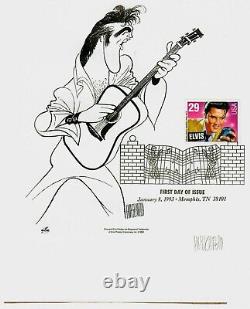Caricaturist Al Hirschfeld Hand Signed Print With Elvis Stamp JG Autographs COA




"Caricaturist" Al Hirschfeld Hand Signed 8X10 Print W/ Elvis Stamp. This item is certified authentic by JG Autographs and comes with their Certificate of Authenticity. (June 21, 1903 - January 20, 2003) was an American. Best known for his black and white portraits of celebrities and.
Al Hirschfeld was born in a two-story duplex at 1313 Carr Street in. And later moved with his family to New York City, where he received his art training at the. Art Students League of New York. Following a divorce from Florence Ruth Hobby, in 1943, he married Broadway actress/performer.
Haas died from ovarian cancer in 1994, aged 84. They had one child, a daughter, Nina b.
In 1996, he married Louise Kerz, a theatre historian. In 1924, Hirschfeld traveled to Paris and London, where he studied painting, drawing and sculpture. Richard Maney, showed one of Hirschfeld's drawings to an editor at the. Which got Hirschfeld commissions for that newspaper and then, later. Hirschfeld's style is unique, and he is considered to be one of the most important figures in contemporary drawing and caricature, having influenced countless artists, illustrators, and cartoonists.
His caricatures were regularly drawings of pure line in black ink, for which he used a genuine. And other newspapers prior to the time they printed in color will be most familiar with the Hirschfeld drawings that are black ink on white illustration board. However, there is a whole body of Hirschfeld's work in color.
Hirschfeld's full-color paintings were commissioned by many magazines, often as the cover. The New York Times Magazine.
He also illustrated many books in color, most notably among them Harlem As Seen By Hirschfeld, with text by William Saroyan. To illustrate a preview magazine featuring the network's new TV programming in fall 1963. One of the programs was.And Hirschfeld's caricature of the show's host. Outraged Funt so much he threatened to leave the network if the magazine were issued. Hirschfeld prepared a slightly different likeness, perhaps more flattering, but he and the network pointed out to Funt that the artwork prepared for newspapers and some other print media had been long in preparation and it was too late to withdraw it. Funt relented but insisted that what could be changed would have to be.


